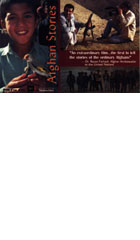
Afghan Stories 2002
Distributed by Seventh Art Releasing, 7551 Sunset Blvd., Suite 104, Los Angeles, CA 90046; 323-845-1455
Produced by Taran Davies & Walied Osman
Directed by Walied Osman
VHS, color, 60 min.
Jr. High - Adult
Middle Eastern Studies, Political Science, Social Science
Date Entered: 11/09/2018
Reviewed by Ernarosa Tominich, MLS, Trocaire College Library, Buffalo NYA couple of weeks after the September 11th bombing of the World Trade Center, filmmaker Taran Davies and Walied Osman, an Afghan-American, travel to Afghanistan from New York City. Their goal is to discover the personal affect of U.S. bombings of the Taliban on Afghan individuals in a country already torn by 24 years of war. In order to get personal perspectives Davies and Osman interview a variety of people. This video records four “living room” interviews reflecting the struggle and hardships forced upon Afghans uprooted and misplaced by war. The first interview is in English. Subsequent interviews are presented with English translation and English subtitles.
The first interview takes place in Queens, NY, with Ad Sharza, a member of the Royal family who was arrested and tortured in Afghanistan. Sharza thinks it would be better to throw a bomb on Afganistan and start from scratch. He says that in Afghanistan there is nothing left of human dignity as well as of the country itself. The family interviewed in Tajikistan shares his opinion.
Tajikistan is a natural gateway into Afghanistan. Here a refugee family of six who lives in a one-room apartment hosts Taran Davies and Walied Osman. After the Soviet occupation of Afghanistan ended in 1989, the Mujahidin, an Islamic resistance to the Soviets, bombed people’s homes. This family was one of them. They left in exile. The wife was a practicing doctor and the husband a professor of journalism. Yet in Tajikistan they cannot find work and are refused a visa due to discrimination against their Afghan nationality. The family survives on money sent to them by relatives living in Canada. Davies and Osman actually record a “personal message” video for this family and deliver it to relatives in Canada.
In Faizabad, North Afghanistan, Davies and Osman stay with a town elder who shows them the local bazaar, mosques and refugee camp. As the town tries to survive, children play among the rubble and dust, the result of years of bombings. The elder longs for a war-free country and hopes that Afghans who have fled will return, and contribute their expertise to the rebuilding of Afghanistan. Next, Davies and Osman travel to the town of Sharu Bazurg. While there, Najib Najibullah, head of the local UN’s World Food Program, hosts them. They meet with the local warlord who controls the town of Sharu Bazurg and also visit the construction of a local road.
The scope of this video is not initially clear due to the organization of the introduction. First the title, Afghan Stories, is not immediately displayed. Secondly use of Afghani background music in the opening scenes of the September 11th bombing of the World Trade Center seems out of context. That the music is Afghani becomes apparent much later in the video particularly for someone unfamiliar with it. Since this video is filmed on location, the light quality of some introductory frames is too bright. Overall however the technical quality of this video is acceptable as editing problems are focused in the introduction.
This video paints a human face to the struggle of children who have only known hunger and war, and families divided by politics. It also addresses the cultural, social and humanitarian concerns of rebuilding lives and communities. This video explains behaviors of the Mujahidin, the Taliban, warlords and other factions of Middle Eastern politics. Due to recent focus on the Middle East, the content of this video can be used as study in the huge undertaking of rebuilding a country decimated by war. In spite of minor technical flaws this video is recommended because of its unique content and firsthand reporting. If used in the classroom additional materials would be needed to supplement the content.